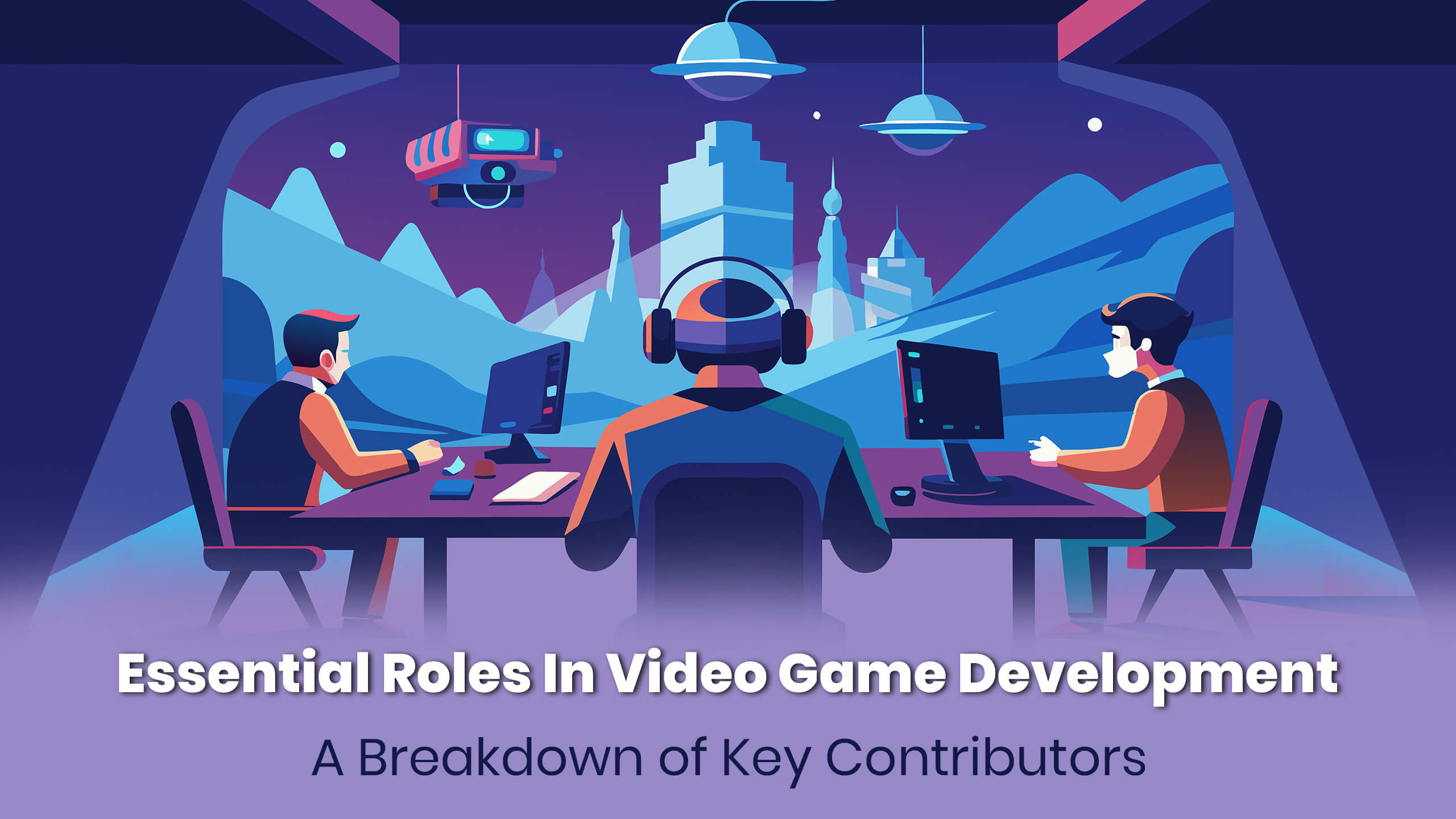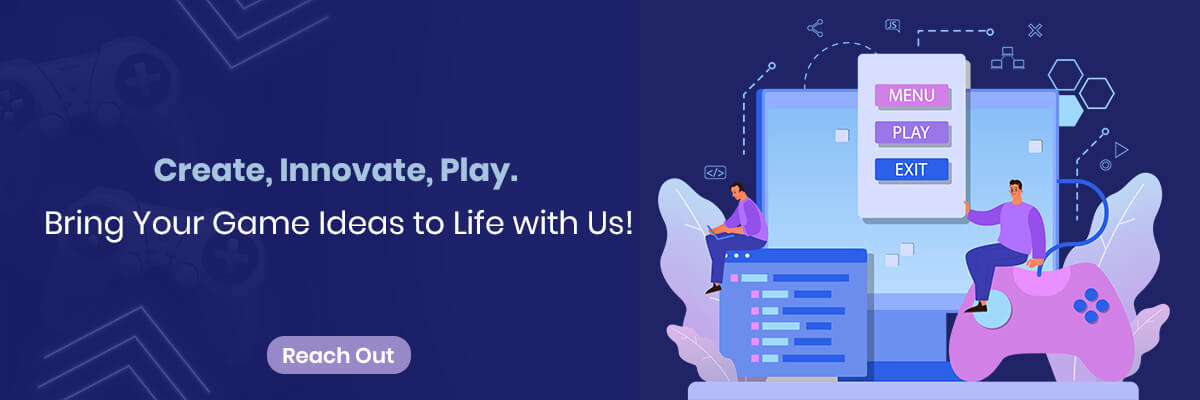The gaming industry has evolved quite a lot in the past few decades. From designing games with immersive experiences to integrating gaming avatars from the metaverse and Web 3.0, the advancements are beyond comprehension and indeed revolutionary. It’s all thanks to the advent of technology, like virtual and augmented reality, artificial intelligence, machine learning, the metaverse, blockchain, and many more. Perhaps that’s why the projected market volume of the video gaming industry is estimated at $363.20 billion by 2027. While it depicts the world of opportunities for both businesses and end users alike, game development is not a one-man action.
In other words, no single person can develop an entire game matching today’s standards and user expectations. Instead, several roles are involved in generating enough contributions for the development process of gaming software, regardless of the niche or genre. That’s why both professionals and gaming development companies need to acknowledge the major contributor roles involved in designing and building state-of-the-art software. With this being said, we have curated a detailed guide, explaining the eight major roles associated with the successful completion of the entire software development life cycle of gaming software.
1. The Producer
A gaming producer can be considered a supervisor and a coordinator who ensures the entire project runs smoothly and that every phase involved in the software development life cycle gets completed on time. He is often responsible for project management and all other associated tasks, like:
- Analyzing market trends and user preferences to know more about the gaming features or types that are in demand
- Planning a budget model and allocating funds to different departments accordingly
- Forming a strong team of developers, designers, and testers for the software development life cycle
- Planning the project’s scope, listing the gaming features to be developed, and streamlining communication between different teams
- Tracking the project’s progress through various parameters and acting meticulously to ensure everyone is on track with the plan
- Mitigating any data or communication silo between the teams along with resolving conflicts through thorough discussion and other strategies
2. The Publisher
Another important role involved with game development is that of a publisher. It can be an entirely different company acting as the mediator between the producer and the development team or a member of the in-house gaming dev team. Regardless of that, a publisher is responsible for several tasks that facilitate the entire software development life cycle and other associated tasks, like fund gathering, dev process management, marketing and promotion, and distribution management. Below we have illustrated some of the major roles of a publisher in the entire game designing and development process.
Contractual Agreement
Publishers are responsible for designing and maintaining contractual agreements between themselves and the developers. They have to work on several aspects of the contracts, like milestones to be achieved, project scope definition, and loyalty program drafts. Apart from this, they also work on defining intellectual property rights, patent applications for the game, and other legal and jurisdictional aspects.
Developer Support
One of the key responsibilities of the publishers is to provide end-to-end support to the development team. For example, they form a proper testing team to ensure the software can be thoroughly tested for various outcomes before the final launch. They decide and create different channels for marketing and promoting the developed software on different platforms. Additionally, they even play a huge role in gathering user feedback and planning continuous discovery and improvement cycles through MVP development and launch.
Creative Control
Publishers use their analytical and critical decision-making powers to influence and navigate the progress of a gaming development project. For example, they can provide their inputs in the game’s design, development stack, testing schedules, hosting servers, and other such matters. Although it might create conflicts with the development team’s vision and bandwidth, such actions are necessary to ensure the project’s scope is as broad and diverse as possible.
Fund Gathering and Allocation
It is the responsibility of publishers to gather funds for the development process of the game from different investors or organize funding campaigns to ensure they have enough monetary backup.
3. The Development Team
The most important role in game development is that of the dev team itself. Often when we hear the term “development team,” we immediately think every involved member is a coder or a programmer. However, in reality, a gaming development team comprises several more roles, including that of a designer, artist, level designer, programmer, and tester. All these people leverage their expertise and hands-on knowledge to complete the software development life cycle and bring the idea to life. No dev team can meet the expectations and design credible and market-ready gaming software if they don’t have any person with the mentioned role.
With this being said, we have briefly described the roles and responsibilities of each person involved and how their contributions influence the efficacy and deliverables of the gaming development company.
The Designer
Every game, no matter how simple it is, needs to be interactive for the players. Otherwise, it won’t be able to generate the immersive experience gamers expect from today’s software designs and architectures. That’s why designers act as the curators of interaction between the gaming software to be developed and the players. Following are the areas they have to work on:
- Gaming mechanics: They develop and decide the rules, challenges, results, and integrated systems that need to be present for the gaming software to meet the ideation logic and function as per the expectations.
- Player psychology: It is the responsibility of the designers to understand the ins and outs of player psychology and accordingly determine the layouts, mechanics, characters, and other features of the software. This helps them to establish a proper order between the gaming challenges and the rewards to keep the players glued to their screens.
- Immersive environments: Another area where designers need to focus on enhancing the immersive experience of the gaming environment. They do so by creating motion sensor objects, amicable sound effects and background music, sceneries, and responsive lighting.
The Artist
The next role that we would like to discuss is that of an artist. He or she will be responsible for enhancing the game’s aesthetics and setting the right tone. For more details, we have described the three major roles of a gaming artist.
- Character planning: Artists work on establishing the characters that will be involved in the game, including the NPCs. They also define the ways these characters will behave, like their dressing sense, power and strength, and so on.
- Environment designing: They also need to work on defining the environments based on the designed concept and the game’s target audience, like the visual effects, different settings, and so on.
- Animations: Also, artists are responsible for creating the animations needed to produce the necessary visual and immersive experience for the players, be it any object or a character.
The Programmer
Programmers or coders take center stage in game development. They leverage their coding knowledge and deep domain expertise to implement the designs and functionalities proposed by the designers and artists. It is also their responsibility to use a custom technology stack to design the backend and frontend layers of the application. Additionally, they work on developing custom APIs for third-party integrations with payment channels, user verification modules, and many more. Programmers need to be technically sound and should have proficiency in multiple programming languages so that they can transform the vision into reality by developing the gaming software and defining all the functionalities.
The Level Designer
Every game has a set of maps and levels that determine the entire architecture of the software. A level designer works on these elements to give the software a proper shape and form. They plan and design the levels to be included in the game, like the beginner’s phase, intermediary levels, and many more. They also work on designing the missions or challenges in a game, planning the layout of all the objects to be included in a particular level, and defining the scope of all the players. Apart from this, level designers are also responsible for integrating all the gameplay elements with the levels, like weapons, magic spells, cars, and many more.
The Tester
Once the gaming software is developed, it needs to be thoroughly tested before the final launch. Here comes the testing team, who verifies if the developed software is working as per the project scope or if there are any deviations in performance and functionalities. Following are the major areas that testers work on:
- Checking the functional flow of the gaming software, like navigation between different windows, motion of the characters, gaming layouts, and many more.
- Verifying the software’s performance when subjected to different parameters, like varying server load, use of multiple commands, and so on.
- Checking the game’s elements like sound effects, visual effects, responsive lighting, and other parameters and ensuring they are integrated appropriately for an immersive player experience.
Conclusion
With the major roles in game development described above, it’s evident that the process cannot be completed or handled by any single person. In fact, the producer, publisher, and development teams need to work closely and collaboratively to bring the game to life and turn the vision into reality. So, if you are planning to launch a game that adheres to the current market standards and can provide an omnichannel player experience, you can collaborate with Web 3.0 India a leading gaming development company in India, We have professionals working in all the above-mentioned roles.





